ERS Charts of Note
Subscribe to get highlights from our current and past research, Monday through Friday, or see our privacy policy.
Get the latest charts via email, or on our mobile app for  and
and 
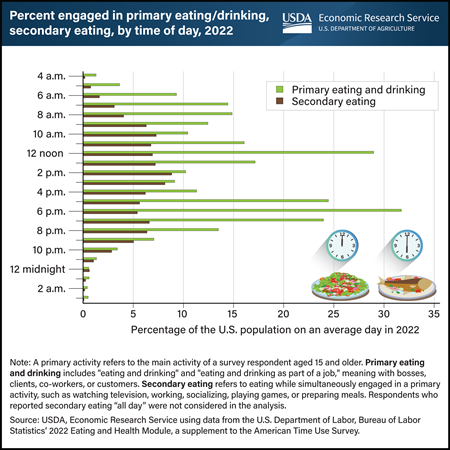
Tuesday, November 28, 2023
Throughout an average day in 2022, individuals aged 15 and older exhibit two distinct peak time blocks for primary eating and drinking—between 12 noon and 12:59 p.m. and from 6 to 6:59 p.m. About 3 in 10 individuals engaged in primary eating and drinking during each of these periods. While some people prefer to eat and drink while not doing anything else (primary eating and drinking), others opt for grazing while multitasking (secondary eating). Notably, between 9 a.m. and 9:59 p.m., at least 5 percent of U.S. residents participated in secondary eating each hour in 2022. The top five concurrent activities during secondary eating included watching television and movies, paid work, socializing with others, playing games, and food and drink preparation. Examining the eating patterns of the U.S. population is key to better understanding the determinants of dietary intake and diet-related health status. This data and chart come from the USDA, Economic Research Service’s Eating and Health Module (ATUS) data product, which is part of the nationally representative American Time Use Survey.
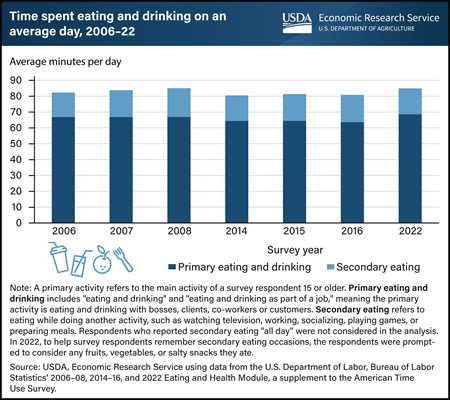
Wednesday, November 8, 2023
On an average day in 2022, individuals 15 and older spent 68.5 minutes engaged in eating and drinking as a “primary,” or main, activity. USDA, Economic Research Service (ERS) sponsors and maintains data on time spent eating and drinking for the Eating and Health Module, a supplement to the U.S. Department of Labor, Bureau of Labor Statistics’ American Time Use Survey (ATUS). Information about the time and location U.S. residents spend eating and drinking can offer valuable insights into how nutrition and health outcomes vary over time and can inform the design of food assistance and nutrition policies and programs. ERS researchers found that respondents devoted an extra 16.4 minutes to eating as a secondary activity, which means eating while doing something else, such as watching television, working, socializing, playing games, or preparing meals. In 2022, the top two places for primary eating and drinking and secondary eating were “own home or yard” and “workplace.” Overall, individuals in the United States aged 15 and older allocated 85 minutes to both primary eating and drinking and secondary eating on an average day in 2022. This is a modest increase of about 4 minutes compared with the survey data from 2016. This data and chart come from the ERS Eating and Health Module (ATUS) data product, which is part of the nationally representative ATUS.
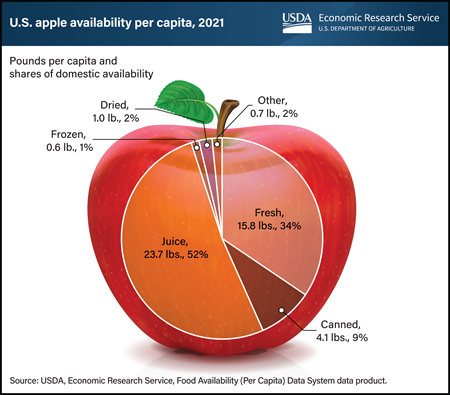
Wednesday, September 20, 2023
Apples are a fall staple, showing up in lunch boxes, pies, cobblers, crisps, and cider. In 2021, 45.9 pounds of apples per person were available for domestic consumption, according to USDA, Economic Research Service’s (ERS) Food Availability data product. Fifty-two percent of the available apples for U.S. domestic use (23.7 pounds per person) was in the form of juice or cider, or about 2 gallons per person. Fresh apples accounted for 34 percent (15.8 pounds per person). Canned, frozen, dried, and other forms made up the remaining 14 percent of apple availability in 2021. Over the last 10 years, per-person apple availability reached a high of 49.2 pounds per person in 2016. Much of the decrease since 2016 was because of declining availability of fresh apples. In 2016, fresh apple availability was 19.3 pounds per person. This chart uses data from ERS’ Food Availability (Per Capita) Data System (FADS), updated in April 2023.
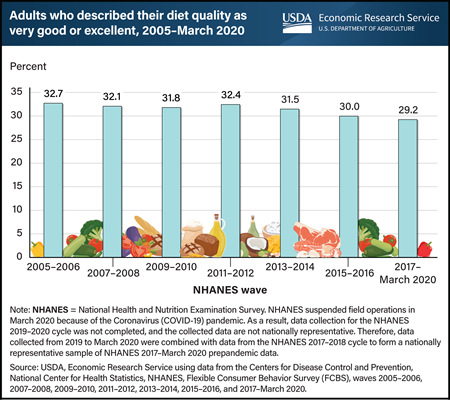
Wednesday, September 13, 2023
In the period covering January 2017 to March 2020, just under 3 in 10 adults, or 29 percent, reported the healthfulness of their diets was “very good” or “excellent.” That is 3.5 percentage points lower than the corresponding share reported in 2005–06. These data can be found in the latest publicly available wave of the Flexible Consumer Behavior Survey (FCBS), which collects information on U.S. consumers’ knowledge, attitudes, and beliefs about nutrition and food choices. For context, 41 percent of adults surveyed in the 1989–1991 Continuing Survey of Food Intakes of Individuals rated the healthfulness of their diets as “very good” or excellent, suggesting a continuing downward trend in the health quality individuals ascribe to their diets. In the 2017–March 2020 survey, adults age 20 and over were asked to assess their diet quality by responding to the question: “In general, how healthy is your overall diet?” They could choose “poor,” “fair,” “good,” “very good,” or “excellent.” Since 2007, USDA, Economic Research Service (ERS) has sponsored the FCBS by providing partial funding for data collection and survey administration. FCBS is a module of the National Health and Nutrition Examination Survey (NHANES) and its data reflect national trends about changing dietary behaviors of U.S. consumers. This chart appears on ERS’ Flexible Consumer Behavior Survey topic page, updated in June 2023.
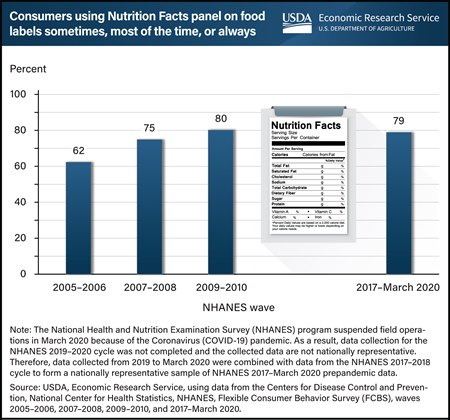
Thursday, July 20, 2023
Nearly 4 out of 5 adults aged 20 and older reported they regularly used the Nutrition Facts panel when deciding to buy a food product during the most recent wave of the Flexible Consumer Behavior Survey (FCBS), from 2017 to March 2020. That is 79 percent, which is much higher than the 62 percent of adults who reported regular use of the Nutrition Facts panel in 2005–06. Regular use includes using the panel “sometimes,” “most of the time,” or “always” in food purchasing decisions. The Nutrition Facts panel on packaged foods lists the amount of calories, fat, fiber, carbohydrates, and some other nutritional information—all of which helps consumers compare products and make healthier food choices. Standardized nutrition information became accessible to U.S. consumers on almost all packaged foods sold in grocery stores, supermarkets, superstores, and other retail stores following the Nutrition Labeling and Education Act of 1990. Since 2007, USDA, Economic Research Service (ERS) has sponsored the FCBS by providing partial funding for data collection and survey administration. FCBS is a module of the National Health and Nutrition Examination Survey (NHANES), which collects information on U.S. consumers’ knowledge, attitudes, and beliefs about nutrition and food choices. This chart appears on ERS’ Flexible Consumer Behavior Survey topic page, updated in June 2023.
-FAH-Spending-by-Race_450px.png?v=6994.3)
Monday, July 10, 2023
U.S. households shifted away from buying foods at restaurants and other food service venues to food-at-home (FAH) outlets such as grocery stores and other retail establishments in 2020. The largest FAH shifts came from a category designated by USDA, Economic Research Service (ERS) as “all other FAH,” which includes prepared meals and salads, desserts, and foods not elsewhere classified such as soups, savory snacks, candy, sweeteners, margarine, and butter. “All other FAH” was by far the largest FAH category before 2020, and its share of the household food budget increased by 2.6 percentage points in 2020 compared with the period from 2016 to 2019. However, this increase was unevenly distributed across racial and ethnic populations and among subcategories within “all other FAH.” All U.S. racial and ethnic subpopulations except Hispanic households increased their total food budget share for “all other FAH” during this period. Black households increased their budget shares for “all other FAH” the most, followed by Asian households. The increase by Asian households on “all other FAH” was driven by a 1.6-percentage-point rise in prepared meals and salads and a 1.8-percentage-point increase in other, not elsewhere classified foods, such as snacks. In contrast, Black households had a larger increase in other, not elsewhere classified foods (2.0 percentage points) and desserts (1.4 percentage points). This chart appears in the ERS Amber Waves article, New Analysis Approach Illuminates Differences in Food Spending Across U.S. Populations, published in May 2023.
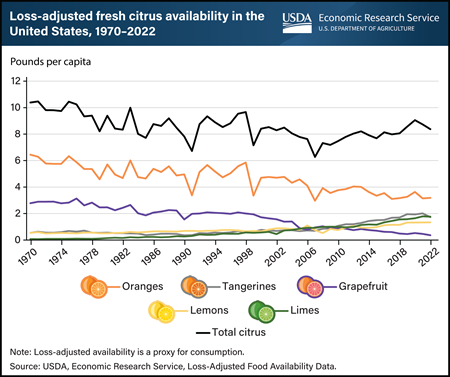
Wednesday, July 5, 2023
In 2022, the total supply of fresh citrus fruits available for consumption in the United States was nearly 8.4 pounds per person after adjusting for spoilage, plate waste, and other losses. From 1970 to 2022, loss-adjusted per person availability of oranges and grapefruit fell by nearly 51 and 87 percent, respectively. Meanwhile, availability of other citrus fruits grew: Lemons doubled, while limes increased by nearly 24 times. Year-to-year changes in availability of citrus fruits reflect swings in production caused by weather events, citrus diseases, changes in import or export volumes, and other factors. Longer trends, however, are usually driven by changes in consumer demand. For example, skipping breakfast—or making it a “grab-and-go” meal—is likely to reduce demand for fresh oranges and grapefruit. Grapefruit takes more effort to eat, especially when compared with easy-to-peel citrus fruits such as tangerines, which are sweeter and smaller. This chart uses loss-adjusted data from USDA, Economic Research Service’s Food Availability (Per Capita) Data System (FADS), April 2023.
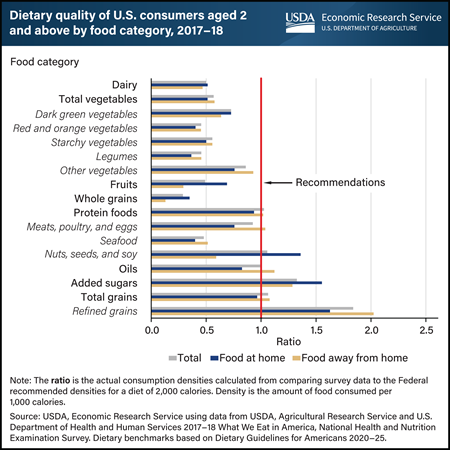
Tuesday, May 23, 2023
U.S. consumers’ eating patterns differ from Federal recommendations for many food categories, and where food is obtained plays a role. Researchers from USDA, Economic Research Service (ERS) and the University of Georgia examined diet patterns based on density—amounts of food consumed per 1,000 calories—using the latest available national food consumption survey data collected in 2017–18. They compared average consumption densities of 17 food categories with what would be needed to match the Dietary Guidelines for Americans recommendations, assuming a 2,000-calorie intake. Average total consumption densities for 11 food categories fell more than 20 percent outside of recommended levels, with whole grains more than 70 percent below the recommended amount. Refined grains, on the other hand, had a consumption density of more than 85 percent above the recommended level. Densities of 6 food categories were within 20 percent of the recommended range. Generally, food purchased at grocery stores, supermarkets, and similar retailers for home preparation had consumption densities more in line with dietary recommendations than food obtained from commercial away-from-home sources (primarily restaurants and fast food establishments). This chart is drawn from the ERS report Dietary Quality by Food Source and Demographics in the United States, 1977–2018, published March 2023.
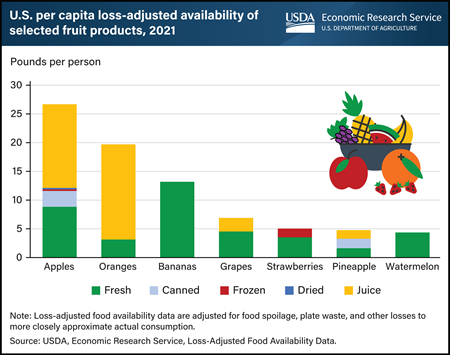
Wednesday, May 10, 2023
Apples held the top spot for total fruit available for consumption in 2021 at more than 26 pounds per person after adjusting for losses. The USDA, Economic Research Service’s (ERS) loss-adjusted food availability data adjusts food availability data for food spoilage, plate waste, and other losses to more closely approximate actual consumption. According to recently released estimates, people in the United States consumed an average of 14.7 pounds (equivalent to 1.7 gallons) of apple juice, roughly 9 pounds of fresh apples, and a total of 3.1 pounds of canned, dried, and frozen apples in 2021. Among the top seven consumed fruits in 2021, apples were the only fruit in which data were available for all five forms: fresh, canned, frozen, dried, and juice. Pineapples were the only other canned option among these seven fruits for which data were available, while strawberries were the only other frozen fruit. Bananas (13.2 pounds per person) topped the list of most popular fresh fruits, while orange juice (16.6 pounds or 1.9 gallons) was the most popular fruit juice in the United States. This chart is drawn from ERS’s Ag and Food Statistics: Charting the Essentials, updated May 2023.
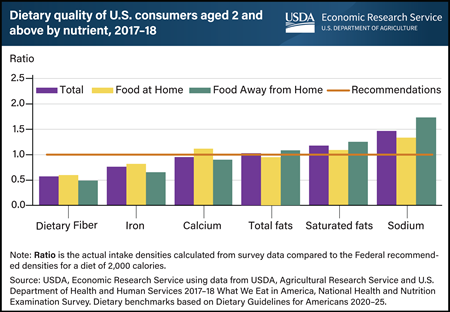
Tuesday, May 2, 2023
U.S. consumers’ intakes of several key nutrients differ from Federal recommendations. Differences are associated with where they obtain food. Researchers from USDA, Economic Research Service (ERS) and the University of Georgia examined diet patterns based on density—amounts of nutrients consumed per 1,000 calories—using the latest available national food consumption survey data collected in 2017–18. They compared average consumption densities of six nutrients with what would be needed to match Dietary Guidelines for Americans recommendations, assuming a typical 2,000-calorie intake. On average, intake densities of dietary fiber and iron were more than 20 percent below the recommended level; calcium densities were closer to the recommended level but still fell short of recommendations. Total fat intake was within 20 percent of the highest recommended percent of calories from total fats, which is 35 percent. The density of saturated fats for food away from home (FAFH) and densities of sodium from all sources (total, food at home, and FAFH) were more than 20 percent above the recommended limit. Generally, the nutrient densities of food purchased at grocery stores, supermarkets, and similar retailers for home food preparation were more in line with dietary guidelines recommendations than those of food obtained from commercial FAFH preparation sources (primarily restaurants and fast food establishments). This chart appears in the ERS report Dietary Quality by Food Source and Demographics in the United States, 1977–2018, published March 2023.
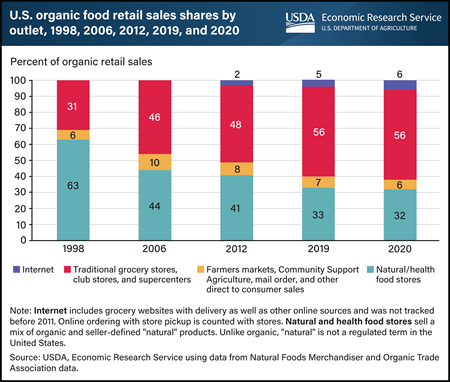
Thursday, March 30, 2023
Markets for organic food began emerging in the 1970s as consumers became concerned about the growing use of synthetic fertilizers and pesticides and their effect on the environment and health. At that time, standards were developed on a State-by-State basis, and organic foods were largely sold in natural food stores. Natural food stores, both large and small, remained the major outlet for organic food sales until the mid-2000s. In 2000, USDA established the National Organic Program and set organic standards for production, along with consistent national labeling. Organic retail food sales moved into conventional grocery retailers, and made up almost 60 percent of retail sales in 2020. Organic food subscriptions such as seasonal fruit baskets, online meal boxes, and other internet sales have created new supply chains for organic food. In 2019, internet sales jumped to 5 percent from 2 percent of total sales in 2012 and rose again in 2020 as consumers responded to the Coronavirus (COVID-19) pandemic. This chart appears in the USDA, Economic Research Service report, U.S. Organic Production, Markets, Consumers, and Policy, 2000–21, published March 2023.
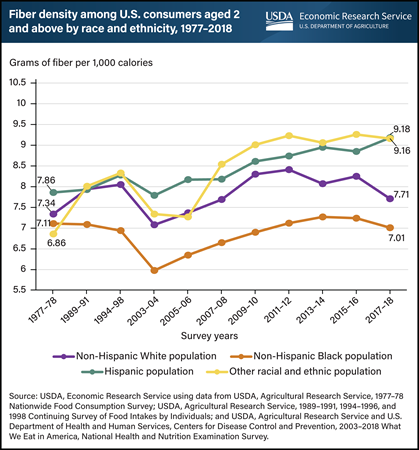
Tuesday, March 28, 2023
According to the 2020-2025 Dietary Guidelines for Americans, low intakes of dietary fiber are a public health concern for the general U.S. population. Improving consumption of dietary fiber may reduce risk of cardiovascular disease, type 2 diabetes, and some types of cancer. The diet of U.S. consumers averaged 8.1 grams of fiber for each 1,000 calories in 2017–18, or 58 percent of the recommended 14 grams per 1,000 calories. Researchers from USDA, Economic Research Service (ERS) and an external collaborator analyzed Federal food consumption survey data spanning the years 1977 through 2018 (the most recent available national data). They found that dietary fiber density, measured as grams of fiber per 1,000 calories in food consumed, did not vary much across race and ethnicity in the 1977–1978 and 1989–1991 survey periods, but the gap in fiber density across race and ethnicity has widened over time. Since 1994–98, the diets of non-Hispanic Black people have been significantly lower in fiber density than those of non-Black people. In 2017–18, Hispanic populations and individuals of other races and ethnicities had a diet of 9.2 grams of fiber per 1,000 calories—significantly higher than the 7.7 and 7 grams consumed by non-Hispanic White people and Black people, respectively. This chart appears in ERS’ report Dietary Quality by Food Source and Demographics in the United States, 1977–2018, published March 2023.
-Fruit-Consumption-at-School_450px.png?v=6994.3)
Wednesday, March 8, 2023
In 2017–18, meals, snacks, and other foods obtained at school were the richest source of fruit for children ages 2 to 19. These foods provided an average of 1.36 cups of fruit per 1,000 calories consumed each day. The USDA, Economic Research Service (ERS) calculated average daily consumption of food groups and selected nutrients by food sources using food consumption data collected by the USDA and Department of Health and Human Services in 2017–18, the latest year for which data are available. Food sources include foods obtained from grocery stores and similar retailers, primarily for home preparation, and foods obtained from away-from-home establishments, such as full-service and fast-food restaurants, and schools. The fruit food group includes whole fruits (fresh, canned, frozen, and dried) and 100 percent fruit juice. The Dietary Guidelines for Americans, 2020–25 recommend individuals 2 years and older consume between 1 and 2.5 cups of fruit per day, depending on age and calorie level of dietary pattern. Breakfasts and lunches from USDA’s school meal programs are required to regularly include fruit. This chart is drawn from the supplemental tables on U.S. food density published in March 2023 with the USDA, Economic Research Service report Dietary Quality by Food Source and Demographics in the United States, 1977–2018.
-Meat-availability_450px.png?v=6994.3)
Wednesday, March 1, 2023
The supply of chicken available to eat in the United States continues to outpace beef, according to food availability data from the USDA, Economic Research Service (ERS). In 2021, 68.1 pounds of chicken per person were available for human consumption (on a boneless, edible basis), compared with 56.2 pounds of beef. The availability of chicken began to increase in the 1940s, overtaking pork availability in 1996 and surpassing beef in 2010 to become the meat most available for U.S. consumption. Since 1980, U.S. chicken availability per person has more than doubled from 32.7 pounds. There were 47.5 pounds of pork available in 2021, after fluctuating between 42.4 and 49.9 pounds per person over the last four decades. Per person fish and shellfish availability data are available only through 2019, when 19.1 pounds were available per person in the United States, up from the low of 8 pounds in 1943. This chart is drawn from ERS’s Ag and Food Statistics: Charting the Essentials, updated December 2022.
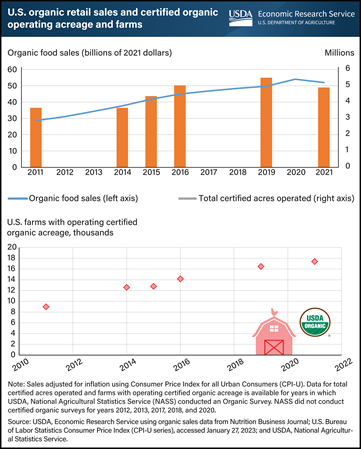
Thursday, February 16, 2023
The organic market has seen continued growth in retail sales in the past decade. U.S. organic retail sales increased by an average of 8 percent per year and surpassed $53 billion in 2020 (inflation-adjusted to 2021 dollars). In 2021, sales were $52 billion, which was a 6-percent annual decline when adjusted for inflation, but a slight increase when not inflation-adjusted. Additionally, the number of certified organic acres operated increased gradually from 3.6 million in 2011 to 4.9 million acres in 2021. The number of certified farms with operating organic acres in the United States nearly doubled over the past decade to 17,409 from about 8,978. Between 2019 and 2021, the number of certified organic farms in the United States increased 5 percent, while total organic land decreased by 11 percent, driven by a 36-percent decrease in pasture and rangeland. These latest data were released in the 2021 Certified Organic Survey on December 15, 2022, by USDA, National Agricultural Statistics Service with cooperation from USDA's Risk Management Agency, which is the first organic survey released by USDA since 2019. The U.S. organic retail sales data provided by Nutrition Business Journal were adjusted for inflation and are available on USDA, Economic Research Service’s Organic Agriculture topic page, updated February 2023.
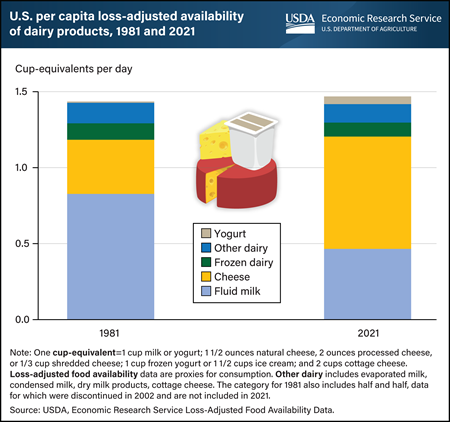
Thursday, February 9, 2023
Overall U.S. dairy consumption rose slightly from 1981 to 2021, but daily cheese consumption more than doubled and consumption of yogurt grew fivefold, according to loss-adjusted food availability data from the USDA, Economic Research Service (ERS). In the data, ERS adjusts the amount of basic commodities available in the food supply by taking into account food spoilage, plate waste, and other losses to more closely approximate actual consumption. Overall loss-adjusted dairy availability totaled 1.5 cup-equivalents per person per day in 2021—half the recommended amount for a 2,000-calorie-per-day diet based on the 2020–2025 Dietary Guidelines for Americans. Daily cheese consumption grew to 0.74 cup-equivalents per person in 2021 from 0.36 cup-equivalents per person in 1981. Yogurt consumption increased to 0.05 cup-equivalents per person from nearly 0.01 cup-equivalents. Fluid milk consumption fell to 0.5 cup-equivalents per person in 2021 from 0.8 cup-equivalents per person in 1981. Several factors contributed to this decline, including competition from alternative beverages, an aging population with differing preferences across generations, and changing consumer attitudes regarding milk fats. This chart is from ERS’s Ag and Food Statistics: Charting the Essentials, updated December 2022.
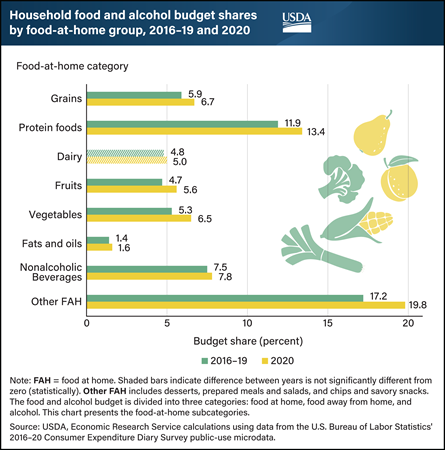
Thursday, January 19, 2023
At the beginning of the Coronavirus (COVID-19) pandemic in 2020, U.S. households shifted away from buying foods at restaurants and other food service venues to food-at-home (FAH) outlets such as grocery stores and other retail establishments. Overall, the share of the household food and alcohol budget spent on FAH increased 7.8 percentage points between the pre-pandemic (2016–19) level and 2020. The largest contributions to this change were the “other FAH” category (including desserts, prepared meals and salads, and chips and savory snacks), which increased 2.6 percentage points, and protein foods (red meat, poultry, eggs, and fish and seafood), which increased 1.5 percentage points. Even though those are the subgroups with the largest changes for household food and alcohol spending, the budget shares for fruits and vegetables showed the fastest growth from 2016–19 to 2020. The share of the average household food and alcohol budget spent on vegetables contributed only 1.2 percentage points to the total but increased 23 percent. The share spent on fruits increased 19 percent (from 4.7 to 5.6 percent). Increases in the share spent on grains, nonalcoholic beverages, and fats and oils also contributed to the overall FAH percentage point gain, but their growth during that period was relatively small. The faster growth of the fruit and vegetable shares in the food and alcohol budget indicates a slight shifting of diets to more produce during the first year of the pandemic. This chart was drawn from the USDA, Economic Research Service report COVID-10 Working Paper: Consumer Food Spending Changes During the COVID-19 Pandemic.
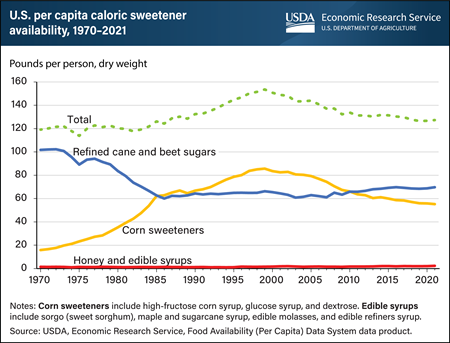
Thursday, December 8, 2022
In 2021, the amount of caloric sweeteners available for consumption in the United States was 17 percent less than in 1999, falling to 127.3 pounds per person from 153.6 pounds. According to the USDA, Economic Research Service’s (ERS) Food Availability (Per Capita) Data System, a reduction in the availability of total corn sweeteners (high-fructose corn syrup, glucose syrup, and dextrose) contributed to the drop. The availability of corn sweeteners fell from a peak of 85.7 pounds per person in 1999 to 55.3 pounds in 2021. Shifting preferences among consumers and food manufacturers, high corn prices, and competition with refined cane and beet sugars and other caloric sweeteners have contributed to this decline. The availability of refined cane and beet sugars fell from 102.3 pounds per person in 1972 to 60.0 pounds in 1986 and remained relatively flat for the next two and a half decades. Refined sugar availability began to rise in 2010, surpassing corn sweeteners in 2011 and reaching 69.7 pounds per person in 2021. Per capita honey availability stood at 1.5 pounds and per capita availability of edible syrups was 0.9 pounds in 2021. This chart is from ERS’s Ag and Food Statistics: Charting the Essentials data product, updated December 2022.
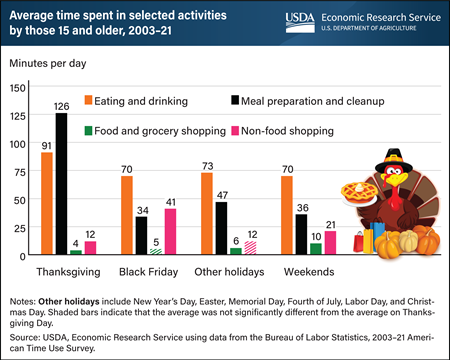
Thursday, November 17, 2022
Do people really spend more time preparing food, eating, drinking, and cleaning up the kitchen on Thanksgiving Day compared with other holidays? Do they really spend more time shopping on Black Friday than on other days? The answer to both questions is “Yes.” Over a survey period from 2003 to 2021, people in the United States spent an average of 91 minutes eating and drinking on Thanksgiving Day. This was 21 minutes greater than the time spent eating and drinking on average for six other major holidays and 21 more minutes than on an average weekend day. Similarly, compared with the average for non-Thanksgiving holidays and weekends, people spent more time preparing meals and cleaning-up on Thanksgiving (126 minutes versus 47 minutes on non-Thanksgiving holidays and 36 minutes on weekends). When it comes to the day after Thanksgiving, people in the United States tend to spend more of their time shopping for items other than food relative to other days. Indeed, people spent 41 minutes shopping for non-food items on an average Black Friday, which is more than 240 percent higher than on an average non-Thanksgiving holiday. For more information, see USDA, Economic Research Service’s (ERS) Eating and Health Module of the American Time Use Survey in ERS’s Eating and Health Module (ATUS) data product.
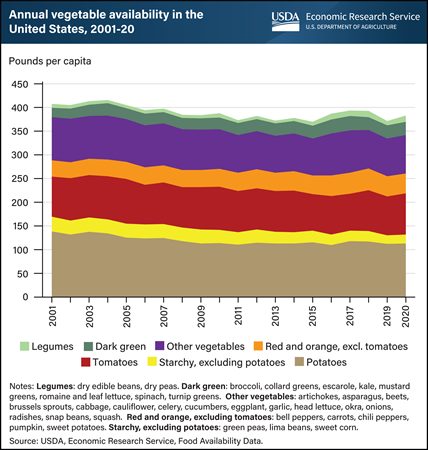
Thursday, November 3, 2022
The overall amount of vegetables available for consumption in the United States has decreased 6 percent over the last two decades to 382.5 pounds per capita in 2020 from 407.3 pounds in 2001. However, vegetable availability rebounded in 2020 from 371.6 pounds in 2019. The vegetables food group is composed of five main subgroups: legumes, other vegetables, dark green, red and orange (including tomatoes), and starchy (including potatoes). Each offers an array of important vitamins, minerals, and dietary fiber. From 2001 to 2020, the combined share of legumes, dark green vegetables, and red and orange vegetables available to eat in the United States increased to more than 44 percent from 36 percent of total vegetables. Availability of legumes, including beans and peas, increased the most over this period—led by an almost 500-percent jump in dry peas—adding additional variety for U.S. consumers. Some vegetable subgroups have increased in popularity, while others have seen declines. Starchy vegetables and “other vegetables,” a subgroup containing 16 different vegetables, declined to 56 percent of total available vegetables in 2020 from 64 percent in 2001. ERS’s Food Availability (Per Capita) Data System (FADS) provides annual estimates of the per-capita availability for more than 200 food commodities consumed in the United States. This chart uses data from FADS, updated in September 2022.


